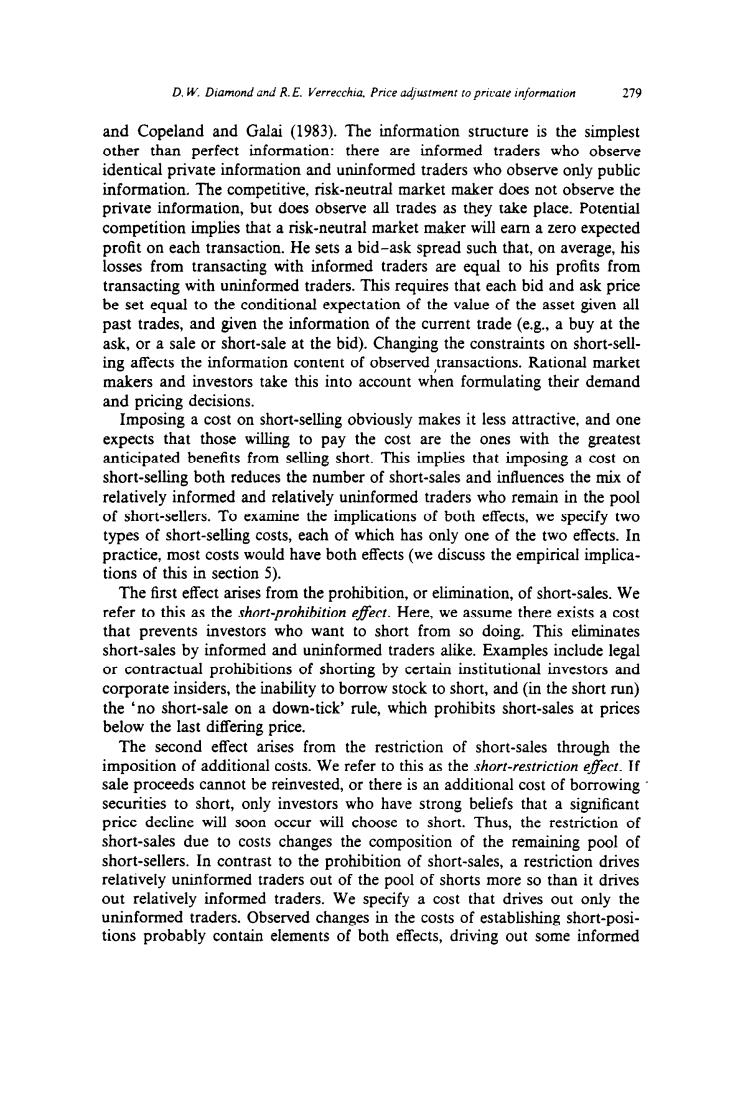正在加载图片...

D.W.Diamond and R.E.Verrecchia.Price adjustment to pricate information 279 and Copeland and Galai (1983).The information structure is the simplest other than perfect information:there are informed traders who observe identical private information and uninformed traders who observe only public information.The competitive,risk-neutral market maker does not observe the private information,but does observe all trades as they take place.Potential competition implies that a risk-neutral market maker will earn a zero expected profit on each transaction.He sets a bid-ask spread such that,on average,his losses from transacting with informed traders are equal to his profits from transacting with uninformed traders.This requires that each bid and ask price be set equal to the conditional expectation of the value of the asset given all past trades,and given the information of the current trade(e.g.,a buy at the ask,or a sale or short-sale at the bid).Changing the constraints on short-sell- ing affects the information content of observed transactions.Rational market makers and investors take this into account when formulating their demand and pricing decisions. Imposing a cost on short-selling obviously makes it less attractive,and one expects that those willing to pay the cost are the ones with the greatest anticipated benefits from selling short.This implies that imposing a cost on short-selling both reduces the number of short-sales and influences the mix of relatively informed and relatively uninformed traders who remain in the pool of short-sellers.To examine the implications of both effects,we specify two types of short-selling costs,each of which has only one of the two effects.In practice,most costs would have both effects(we discuss the empirical implica- tions of this in section 5). The first effect arises from the prohibition,or elimination,of short-sales.We refer to this as the short-prohibition effect.Here,we assume there exists a cost that prevents investors who want to short from so doing.This eliminates short-sales by informed and uninformed traders alike.Examples include legal or contractual prohibitions of shorting by certain institutional investors and corporate insiders,the inability to borrow stock to short,and (in the short run) the 'no short-sale on a down-tick'rule,which prohibits short-sales at prices below the last differing price. The second effect arises from the restriction of short-sales through the imposition of additional costs.We refer to this as the short-restriction effect.If sale proceeds cannot be reinvested,or there is an additional cost of borrowing securities to short,only investors who have strong beliefs that a significant price decline will soon occur will choose to short.Thus,the restriction of short-sales due to costs changes the composition of the remaining pool of short-sellers.In contrast to the prohibition of short-sales,a restriction drives relatively uninformed traders out of the pool of shorts more so than it drives out relatively informed traders.We specify a cost that drives out only the uninformed traders.Observed changes in the costs of establishing short-posi- tions probably contain elements of both effects,driving out some informedD. W. Diamond and R. E. Verrecchla. Pnce adjurment to pricate information 279 and Copeland and Galai (1983). The information structure is the simplest other than perfect information: there are informed traders who observe identical private information and uninformed traders who observe only public information. The competitive, risk-neutral market maker does not observe the private information, but does observe all trades as they take place. Potential competition implies that a risk-neutral market maker will earn a zero expected profit on each transaction. He sets a bid-ask spread such that, on average, his losses from transacting with informed traders are equal to his profits from transacting with uninformed traders. This requires that each bid and ask price be set equal to the conditional expectation of the value of the asset given all past trades, and given the information of the current trade (e.g., a buy at the ask, or a sale or short-sale at the bid). Changing the constraints on short-selling affects the information content of observed ,transactions. Rational market makers and investors take this into account when formulating their demand and pricing decisions. Imposing a cost on short-selling obviously makes it less attractive, and one expects that those willing to pay the cost are the ones with the greatest anticipated benefits from selling short. This implies that imposing a cost on short-selling both reduces the number of short-sales and influences the mix of relatively informed and relatively uninformed traders who remain in the pool of short-sellers. To examine the implications of both effects, we specify two types of short-selling costs, each of which has only one of the two effects. In practice, most costs would have both effects (we discuss the empirical implications of this in section 5). The first effect arises from the prohibition, or elimination, of short-sales. We refer to this as the shorr-prohibition effect. Here, we assume there exists a cost that prevents investors who want to short from so doing. This eliminates short-sales by informed and uninformed traders alike. Examples include legal or contractual prohibitions of shorting by certain institutional investors and corporate insiders, the inability to borrow stock to short, and (in the short run) the ‘no short-sale on a down-tick’ rule, which prohibits short-sales at prices below the last differing price. The second effect arises from the restriction of short-sales through the imposition of additional costs. We refer to this as the short-restriction effect. If sale proceeds cannot be reinvested, or there is an additional cost of borrowing securities to short, only investors who have strong beliefs that a significant price decline will soon occur will choose to short. Thus, the restriction of short-sales due to costs changes the composition of the remaining pool of short-sellers. In contrast to the prohibition of short-sales, a restriction drives relatively uninformed traders out of the pool of shorts more so than it drives out relatively informed traders. We specify a cost that drives out only the uninformed traders. Observed changes in the costs of establishing short-positions probably contain elements of both effects, driving out some informed